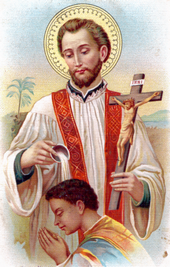

The Spiritual Edifice of St. Francis xavier and the religious edifices of Manapadians
Manapad was the most important city in the Fishery Coast, after Tuticorin. The northern, Gulf. designed by the promontory, which serves as the natural port of Manapad was compared to a turquoise inserted in a setting of golden sands by Fr. Stephen Coube S. J. in the book "At the Country of the Castes: A Journey to the Fishery Coast". Fr. Francis Xavier came to Manapad. A new and incomprehensible environment, in October 1542. The paravars of Manapad had been baptized eight years ago. Yet, it was Fr. Francis who planted the faith there. "When he visited all the villages", says Fr. Bouhours, "he stopped at Manapad for fifteen days...there he gathered all the workers of the Coast. He examined their talents, the character and virtue of each one, moving with them familiarly. Then he assigned to each one a post depending on their temporal and spiritual strength and in order that they could work fruitfully towards the Salvation of Indian souls, he ordered all to study with the greatest care possible Tamil which was spoken in these quarters... "
There was no big church in Mapapad for Fr.Francis. This is evident from his letter dated 23rd April 1544, to Mansilhas at Punaikayal. "It might be better for the women to come to Church on Saturday mornings, as they do at Manapad and the men on Sundays." This may partly have been bcoz the small wattle and daub structures, which were all that Fr.Francis could run to in the way of churches would not have accommodated the entire congregation at any one time, but he also seems to have had a definite policy of keeping men and women apart during their devotions, for undisclosed reasons.
Many are the miracles attributed to St. Francis during his life-time and after his death. Peter Aloysio, the sacristan of Holy Cross ashram confirmed having seen Fr. Francis standing a foot above ground on mid-air for some time while saying mass. Thomas Fcrnando, a Manapadian has seen him sleep-ing in mid-air, a foot above bed. Fr. Francis sent a little boy, giving him his cross to drive the devil out of a wealthy possessed manapadian. Anthony Miranda, fatally, bitten by a poisonous snake, was on of those brought back to life by Fr.Francis. Fr.Francis drank the water with which he cleansed a leper and the leper was made whole. When Mariammal Miranda brought, forth a still-born child and when her pious relative fervently prayed to St. Francis to revive the child to administer baptism to it, the babe opened its eyes ! (A posthumous miracle !) Tradition has it that these were the miracles wrought by St. Xavier at Manapad. Surely it is a mistake to attach much importance to the vague childhood reminiscences of ancient Indians, uneducated and credulous, who regarded marvelas esssential to the make-up of a holy man, be he a yogi or a Christian. In India signs and wonder have always been two a penny, and it was not by such things but by the miracle of his personality that St. Francis Xavier drew so many of her humblest children away from her gods to the only God. Fr. Francis had no gift of tongues. There is no record of his even having heard the private confession of any Asiatic person, which is an indication of his poverty as a linguist. Nor was he like Fr. Beschi a Tamil scholar. In his letter to Br. Mansilhas, he translates "I Believe" of the Creed as ''Enaku Vichuam" instead of "nan visuvasikiren". So much for his gift of tongue. Yet there was a miracle and a great one, for with his pathetic little stock of ill-understood Tamil words, he somehow succeeded in impressing the catholic faith so indelibly on the souls of the primitive tribe that no manner of violence or cajolery by the conquering Dutch could erase it. The Paravars remain the staunchest catholics in India. Very much to the point are the words of Andre Bellessort:'' His (Xxavier's) task would have been made easy had he had the gift of tongue of his predecessor Thomas and then the conversions which he effected would appear less surprising. Why then withdraw a merit while attributing to him a divine favour? He was attached to all the nails of his Cross. They felt great joy for him. And so the question is not so much to know if the miracles which one attributes to him are indisputable as to know why one believed them. One believed them because his life itself was a perpetual miracle ,"
Thus Fr. Francis endeared himself to Paravars by looking after their temporal and spiritual needs and was thus able to build a spiritual edifice at Manapad. The pilgrimage of Fr. Francis Xavier remains as one of I the Most heroic efforts of human nature. His dream has ennobled the world.
ST. FRANCIS XAVIER'S GROTTO :
Rev. Fr. Jean-Baptiste Dassal S. J. in his book "Rev, Fr. Louis Verdier" describes the grotto thus : " The extreme point of the, promontory is preserved at first by a range of rocky battlements almost in level with water, against which dash with fury the waves of the sea. In the clift clouded by the mist of the foam stands a tripple-naved grotto, twelve paces deep and as much broad. According to all appearance, it was hewn by man to serve as an idolatory temple. Tradition has it that its guardian, a saivite penitent gave it to St. Francis when he first visited those parts. It served St. Francis as a private chapel. A spring bored in rock on the right of the nave as one enters yields excellent sweet water from the bottom of the sea basin: The missionary of Manapad had disengaged the sandy excavation which encroached it, gave to its facade a religious aspect and crowned his labour by planting a big wooden cross".
Archaeologist H. Sarkar gives a description of the cave and assigns a date to it. Facing eastward, this modest excavation with its opening toward the sea, has a depth of thirty two feet; it has in main a pillared hall, measuring 16'4" X 17'6" having a constricted vestibule (5' 6" X 8') fronted by ,a porch (12' in breadth) all place, axially. Four pillars two in each row divide the main hall into three bays; they are plain and rectangular in section. The uttra or beam that runs over the portika or corbel has been transformed into arches rising between the two pillars; perhaps it is not an original feature. Likewise the depressions on the smooth wall surface simulating niches-three on the northern and one each on the eastern and the western sides -are probably for transforming it into a church. The altar with the standing figure of Xavier at the back wall of the cave had been raised after cutting the rock to a depth of about one foot...The circular wall has an internal diameter of 3' 3". The cave ought to have come into existence before the middle of the ninth century. It must have been used as a cave resort of sanyasis by about the first half' of the ninth century, if not earlier. It is not unlikely that these caves were used by the Saiva saints, as most of the early monuments are saivite in character".
HOLY CROSS CHURCH ;
As witnesses to its glorious past, Manapad guards four churches. Of all the churches, Holy Cross Church is the most celebrated. Rev. Fr. Denis ,Guchen in his book `Cinquante Ans Au Madure' (Fifty years at Madurai) says, "Built in honour of the True Cross of Our Lord, this sanetury enjoys a grand reputation in the whole of Madurai. 'It is at the Church of the Holy Cross of Manapad that the various Courts of Justice of Tirunelveli get often terminated the litigious affairs which the judges could not succeed in bringing to light with help the of witnesses. (It was done by making one of the parties swear that they were speaking the truth and nothing but the truth. Those who swore falsely became blind). Fr. Laurent who had ruled the christendom of Manapad for 28 years from 1852 to 1877 had much laboured to enlarge and decorate this church."
Fr. Guchen narrates a grace miraculously obtained these last year at Manapad, by the virtue of the Cross of Our Lord : A paravan of Manapad went on business to Cochin. There, far away from his family, he was subjected to a rude trial : He lost his vision. The doctors having given up his case as incurable, he went to Colombo in the island of Ceylon. Even there medical science proved ineffective. He was however, optimistic and confident. He said to himself: "At the Church of the Holy Cross many have become blind on account of the false oaths they made there. The sacred relic of the Sacred Tree on which Our Savior died will give me back my vision. Back at Manapad, promising a votive offering, to the church of the Holy Cross, he went to the venerated sanctuary in the company of his family, parents and friends. Candles in hand, they prostrated in the church. But because of negligence, or because of emotional trouble, or because Divine Providence directed things that way, the candles were not lit. However our blind man prayed with fervor and his little children, much sad at their father's blindness, prayed too. "Jesus, Light of the world, giver of Light to those who hope in You," said the brave man, "by the adorable Cross on which You died for me, render me, I pray to you, the light of my eyes." And the children repeated "Jesus, Light of the World, we implore you to render light to our father's eyes.
These stone monuments which serve as Chusches of God still stand as silent witnesses to the past glory of Manapad.,
By P.N. Diaz, M.A., P.G.D.T.E.






